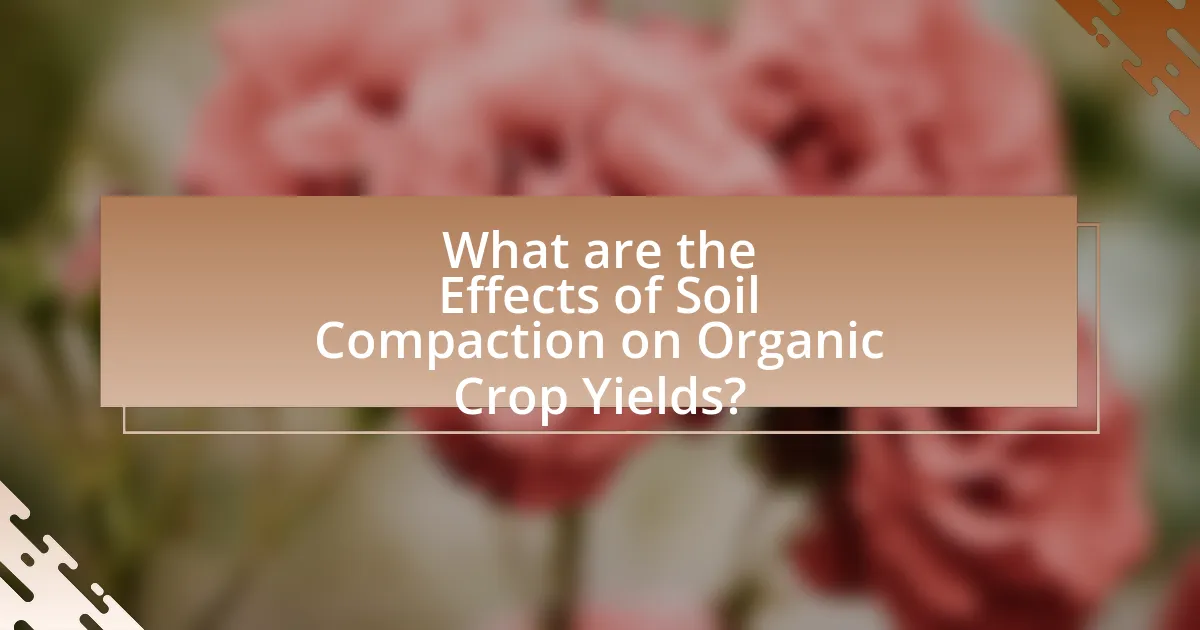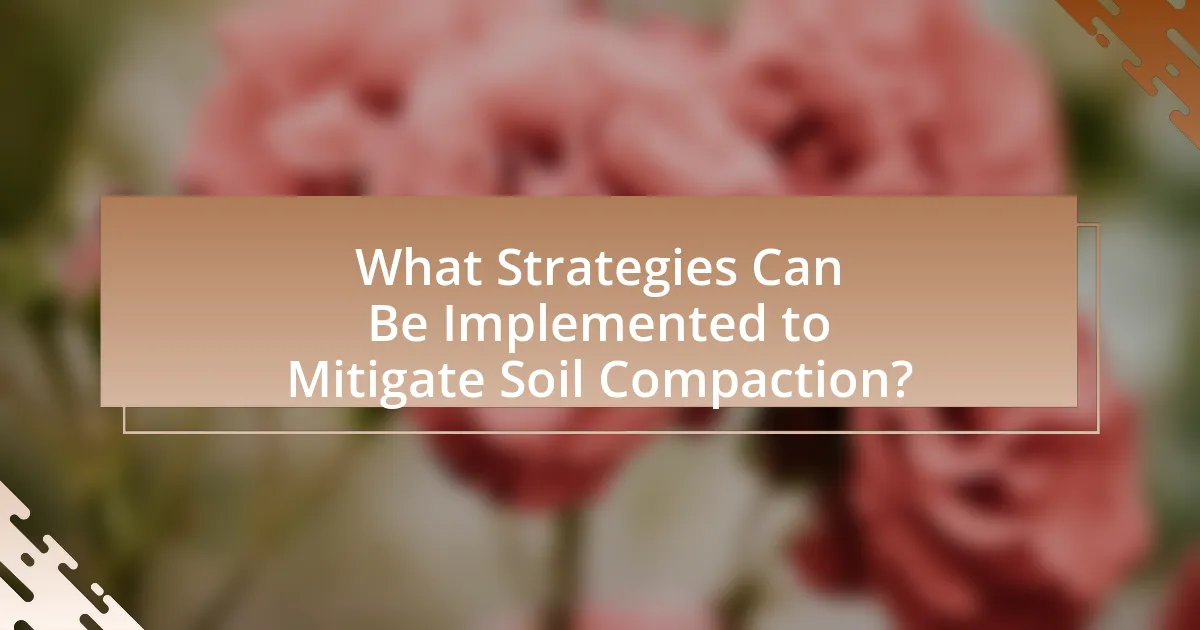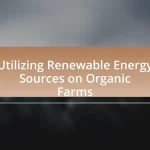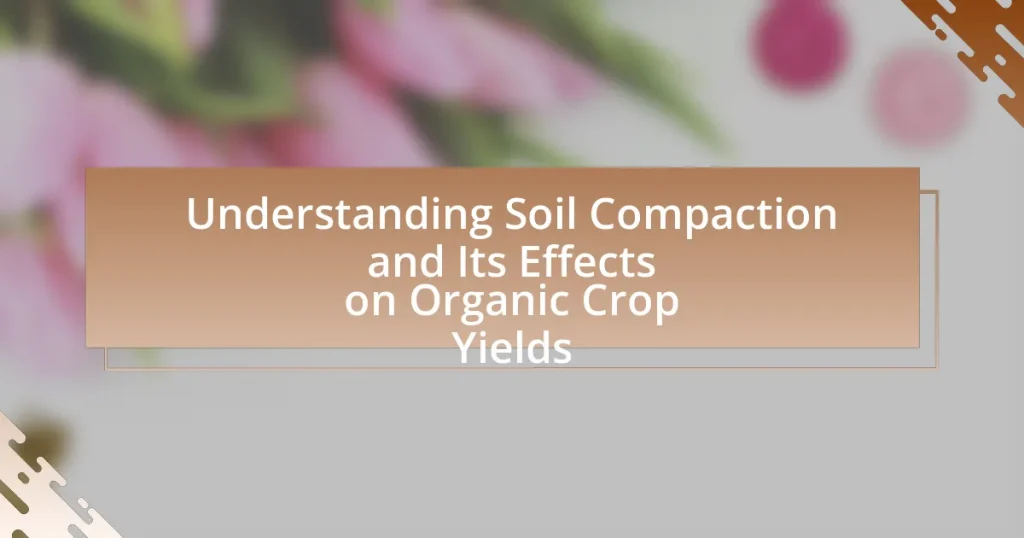Soil compaction is the process of soil particles being pressed together, leading to reduced pore space and increased density, which significantly impacts organic crop yields. This article examines the causes of soil compaction in agricultural settings, including machinery use and livestock trampling, and discusses its detrimental effects on root growth, water infiltration, and nutrient availability. Key indicators of compaction, methods for identification, and tools for measurement are outlined, along with strategies for mitigation such as crop rotation, cover cropping, and reduced tillage practices. The economic implications of reduced crop yields due to compaction are also addressed, emphasizing the importance of effective soil management for sustainable organic farming.

What is Soil Compaction and Why is it Important for Organic Crop Yields?
Soil compaction is the process by which soil particles are pressed together, reducing pore space and increasing soil density. This phenomenon is crucial for organic crop yields because it affects root growth, water infiltration, and nutrient availability. Compacted soil restricts root expansion, leading to decreased access to water and nutrients, which are vital for plant health and productivity. Research indicates that soil compaction can reduce crop yields by up to 30% due to impaired root development and reduced soil aeration, highlighting its significant impact on organic farming practices.
How does soil compaction occur in agricultural settings?
Soil compaction in agricultural settings occurs primarily due to the weight of machinery and livestock, which compresses soil particles and reduces pore space. This process leads to decreased soil aeration and water infiltration, negatively impacting root growth and crop yields. Studies indicate that repeated traffic from heavy equipment can increase soil bulk density by up to 20%, significantly hindering plant development and nutrient uptake.
What are the primary causes of soil compaction in organic farming?
The primary causes of soil compaction in organic farming include heavy machinery use, livestock trampling, and inadequate soil management practices. Heavy machinery, such as tractors, exerts significant pressure on the soil, leading to increased density and reduced porosity. Livestock trampling, particularly in pastures, compresses the soil structure, further exacerbating compaction issues. Additionally, inadequate soil management practices, such as insufficient crop rotation and lack of cover crops, can lead to soil degradation and compaction over time. These factors collectively hinder water infiltration, root growth, and overall soil health, negatively impacting organic crop yields.
How does soil texture influence compaction levels?
Soil texture significantly influences compaction levels, as finer-textured soils, such as clay, tend to compact more easily than coarser-textured soils like sand. This is due to the smaller particle size and greater surface area of clay, which allows for more water retention and increased cohesion among particles, leading to higher compaction under pressure. Research indicates that compacted clay soils can have reduced porosity and permeability, negatively affecting root growth and water infiltration, which are critical for organic crop yields. In contrast, sandy soils, with larger particles and lower cohesion, are less prone to compaction, allowing for better aeration and drainage, thus supporting healthier crop growth.
What are the key indicators of soil compaction?
The key indicators of soil compaction include increased bulk density, reduced porosity, and decreased infiltration rates. Increased bulk density occurs when soil particles are pressed together, leading to a denser soil structure that can impede root growth and water movement. Reduced porosity indicates less space for air and water, which is essential for healthy plant development. Decreased infiltration rates signify that water cannot easily penetrate the soil, resulting in surface runoff and potential erosion. These indicators are critical for assessing soil health and understanding how compaction affects organic crop yields.
How can farmers identify compacted soil in their fields?
Farmers can identify compacted soil in their fields by observing physical signs such as reduced water infiltration, poor root growth, and surface crusting. These indicators suggest that soil particles are densely packed, limiting air and water movement. Additionally, farmers can conduct a simple test by inserting a soil probe or digging a small hole; if resistance is felt or if the soil is difficult to penetrate, compaction is likely present. Research indicates that compacted soil can lead to decreased crop yields, emphasizing the importance of early identification and management.
What tools are available for measuring soil compaction?
Tools available for measuring soil compaction include penetrometers, soil compaction testers, and nuclear density gauges. Penetrometers measure the resistance of soil to penetration, providing a direct indication of compaction levels. Soil compaction testers, such as the Clegg Impact Soil Tester, assess compaction by measuring the deceleration of a falling mass. Nuclear density gauges utilize radioactive isotopes to determine soil density and moisture content, offering precise measurements of compaction. These tools are widely used in agricultural and construction settings to ensure optimal soil conditions for crop yields and structural integrity.

What are the Effects of Soil Compaction on Organic Crop Yields?
Soil compaction negatively affects organic crop yields by reducing soil porosity, which limits root growth and water infiltration. Compacted soil can lead to decreased aeration and nutrient availability, ultimately resulting in lower crop productivity. Research indicates that soil compaction can reduce yields by as much as 20% to 50% in certain crops, depending on the severity of compaction and soil type. Studies have shown that organic crops, which rely on healthy soil ecosystems, are particularly sensitive to these changes, as they depend on soil structure for optimal growth and nutrient uptake.
How does soil compaction impact root development?
Soil compaction negatively impacts root development by restricting root growth and reducing soil aeration. Compacted soil creates a dense layer that limits the ability of roots to penetrate and access essential nutrients and water. Research indicates that soil compaction can decrease root biomass by up to 50%, as roots struggle to navigate through tightly packed soil particles. This reduction in root growth can lead to decreased plant vigor and lower crop yields, particularly in organic farming systems where soil health is crucial for productivity.
What role does soil aeration play in root health?
Soil aeration is crucial for root health as it facilitates the exchange of gases, allowing roots to access oxygen necessary for respiration. Adequate oxygen levels in the soil promote root growth and function, enhancing nutrient uptake and overall plant vitality. Research indicates that well-aerated soils can significantly improve root development, leading to increased crop yields. For instance, a study published in the Journal of Soil Science found that crops grown in aerated soils exhibited a 20% increase in root biomass compared to those in compacted soils, demonstrating the direct impact of soil aeration on root health and productivity.
How does compaction affect nutrient uptake in crops?
Compaction negatively affects nutrient uptake in crops by reducing soil porosity and limiting root growth. When soil becomes compacted, the density increases, which restricts the movement of air, water, and nutrients to plant roots. Research indicates that compacted soils can lead to decreased root biomass and impaired root function, ultimately resulting in lower nutrient absorption. For instance, a study published in the Soil Science Society of America Journal found that compacted soils reduced the uptake of essential nutrients like nitrogen and phosphorus by up to 30%. This demonstrates that soil compaction directly hinders the ability of crops to access vital nutrients necessary for growth and yield.
What are the long-term consequences of soil compaction on crop yields?
Soil compaction significantly reduces crop yields over the long term. This reduction occurs due to decreased soil porosity, which limits root growth and water infiltration, leading to poor nutrient uptake. Research indicates that compacted soils can reduce crop yields by 10% to 30%, depending on the severity of compaction and crop type. Additionally, studies show that compaction can lead to increased soil erosion and reduced microbial activity, further diminishing soil health and productivity.
How does compaction influence soil moisture retention?
Compaction decreases soil moisture retention by reducing the pore space available for water storage. When soil is compacted, the particles are pressed closer together, leading to a denser structure that limits the ability of water to infiltrate and be held within the soil. Research indicates that compacted soils can have significantly lower water-holding capacity, with studies showing that compaction can reduce moisture retention by up to 50% compared to non-compacted soils. This reduction in moisture availability can adversely affect plant growth and crop yields, particularly in organic farming systems that rely on optimal soil moisture for healthy crop development.
What are the economic implications of reduced crop yields due to compaction?
Reduced crop yields due to soil compaction lead to significant economic implications, primarily manifested in decreased agricultural productivity and increased production costs. When soil is compacted, root growth is restricted, limiting plants’ access to water and nutrients, which can result in yield reductions of up to 30% in severe cases. This decline in yield directly impacts farmers’ revenues, as lower output translates to reduced sales and profitability. Additionally, farmers may incur higher costs for inputs such as fertilizers and irrigation to compensate for the diminished soil health and crop performance. Research indicates that the economic losses from reduced yields can exceed $1 billion annually in the United States alone, highlighting the critical need for effective soil management practices to mitigate compaction effects.

What Strategies Can Be Implemented to Mitigate Soil Compaction?
To mitigate soil compaction, strategies such as implementing crop rotation, using cover crops, and employing reduced tillage practices can be effectively utilized. Crop rotation enhances soil structure and health by diversifying root systems, which helps break up compacted layers. Cover crops, such as legumes, improve soil aeration and organic matter, further reducing compaction. Reduced tillage minimizes soil disturbance, preserving soil structure and promoting beneficial microbial activity. Research indicates that these practices can significantly enhance soil porosity and water infiltration, leading to improved organic crop yields.
How can farmers prevent soil compaction during planting and harvesting?
Farmers can prevent soil compaction during planting and harvesting by implementing practices such as using lighter equipment, maintaining proper tire pressure, and employing controlled traffic farming. Lighter equipment reduces the weight on the soil, minimizing compaction, while maintaining proper tire pressure ensures that machinery does not exert excessive force on the soil surface. Controlled traffic farming involves designating specific paths for machinery, which limits the areas of soil that are compacted, allowing other areas to remain undisturbed. Research indicates that these practices can significantly enhance soil structure and improve organic crop yields by maintaining soil aeration and water infiltration.
What practices can be adopted to improve soil structure?
To improve soil structure, practices such as adding organic matter, implementing crop rotation, and minimizing soil disturbance can be adopted. Adding organic matter, like compost or well-rotted manure, enhances soil aggregation and increases porosity, which improves water retention and aeration. Crop rotation introduces diverse root systems that can break up compacted layers and enhance soil health. Minimizing soil disturbance through no-till or reduced-till farming preserves soil structure and microbial communities, which are essential for nutrient cycling. Research indicates that these practices can significantly enhance soil structure, leading to improved crop yields and sustainability in organic farming systems.
How does crop rotation contribute to soil health and compaction prevention?
Crop rotation enhances soil health and prevents compaction by promoting biodiversity and improving soil structure. Different crops have varying root systems, which can break up compacted layers and enhance soil aeration and water infiltration. For instance, deep-rooted plants like alfalfa can penetrate hardpan layers, while cover crops such as clover add organic matter, improving soil texture and nutrient availability. Research indicates that fields practicing crop rotation show increased microbial activity and organic matter levels, which are crucial for maintaining soil health. Studies have demonstrated that crop rotation can reduce soil compaction by up to 20% compared to monoculture systems, thereby supporting sustainable agricultural practices.
What are the best practices for managing compacted soil?
The best practices for managing compacted soil include aeration, organic matter addition, and proper crop rotation. Aeration involves using tools like aerators or tillers to break up compacted layers, allowing air, water, and nutrients to penetrate the soil more effectively. Adding organic matter, such as compost or mulch, improves soil structure and enhances microbial activity, which can alleviate compaction over time. Implementing a proper crop rotation strategy helps maintain soil health by preventing the overuse of specific nutrients and promoting diverse root systems that can break up compacted layers. Research indicates that these practices can significantly improve soil structure and enhance organic crop yields, as demonstrated in studies conducted by the USDA Agricultural Research Service.
How can cover crops be used to alleviate soil compaction?
Cover crops can alleviate soil compaction by improving soil structure and enhancing root penetration. The deep root systems of cover crops, such as radishes and clover, create channels in the soil, which helps to break up compacted layers. Research indicates that cover crops can increase soil porosity and reduce bulk density, leading to improved water infiltration and aeration. For instance, a study published in the journal “Soil Science Society of America Journal” found that using cover crops significantly reduced soil compaction levels in agricultural fields, thereby enhancing overall soil health and crop productivity.
What role does tillage play in managing soil compaction?
Tillage plays a crucial role in managing soil compaction by breaking up compacted layers, improving soil structure, and enhancing aeration. Through mechanical disturbance, tillage reduces bulk density, allowing roots to penetrate more easily and facilitating water infiltration. Research indicates that proper tillage practices can significantly decrease soil compaction levels, leading to improved crop yields. For instance, a study published in the Soil Science Society of America Journal found that reduced tillage systems can lower soil compaction and enhance organic matter content, which is vital for maintaining soil health and productivity in organic farming systems.
What practical tips can farmers use to enhance organic crop yields despite soil compaction?
Farmers can enhance organic crop yields despite soil compaction by implementing practices such as crop rotation, cover cropping, and the use of organic amendments. Crop rotation helps break pest and disease cycles while improving soil structure, which can mitigate compaction effects. Cover cropping, particularly with deep-rooted species, can improve soil aeration and organic matter content, further alleviating compaction. Additionally, incorporating organic amendments like compost or well-rotted manure increases soil fertility and enhances microbial activity, which can improve soil structure and water retention. Research indicates that these practices can lead to improved yields and soil health, demonstrating their effectiveness in managing the challenges posed by soil compaction.










